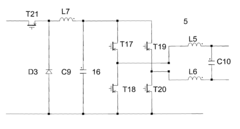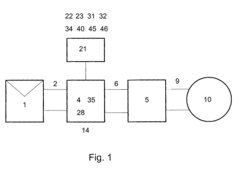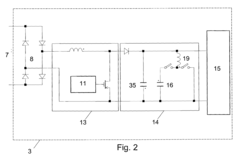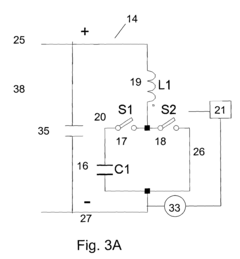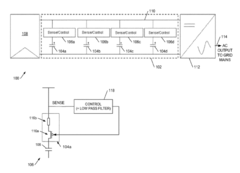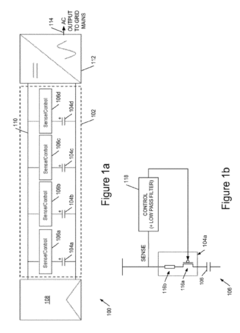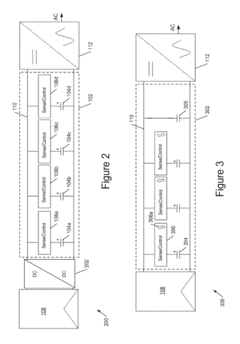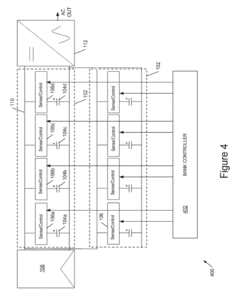Solar Inverter Reliability: Enhancing System Resilience
JUL 17, 20259 MIN READ
Generate Your Research Report Instantly with AI Agent
Patsnap Eureka helps you evaluate technical feasibility & market potential.
Solar Inverter Evolution and Reliability Goals
Solar inverter technology has undergone significant evolution since its inception in the 1990s. Initially designed for simple DC to AC conversion, modern solar inverters have become sophisticated devices capable of managing complex power flows and grid interactions. The primary goal in this evolution has been to enhance system reliability and resilience, crucial factors in the widespread adoption of solar energy.
The development of solar inverters has been driven by the need for increased efficiency, improved power quality, and better grid integration. Early inverters were plagued by issues such as high failure rates, poor power quality, and limited functionality. As the solar industry matured, inverter manufacturers focused on addressing these challenges, leading to substantial improvements in reliability and performance.
One of the key reliability goals for solar inverters is to extend their operational lifespan to match or exceed that of solar panels, typically 25-30 years. This longevity is essential for reducing the overall cost of solar energy systems and minimizing maintenance requirements. Achieving this goal involves improving component quality, enhancing thermal management, and implementing advanced control algorithms to reduce stress on critical components.
Another crucial objective is to enhance the inverters' ability to withstand harsh environmental conditions. Solar installations are often exposed to extreme temperatures, humidity, and dust, which can significantly impact inverter performance and lifespan. Manufacturers are continually developing more robust designs and materials to ensure inverters can operate reliably in diverse climates.
Grid stability and power quality have also become central to solar inverter reliability goals. As solar penetration increases, inverters must play a more active role in supporting grid stability. This includes features such as reactive power control, voltage regulation, and fault ride-through capabilities. These advanced functions not only improve overall system reliability but also enable higher levels of solar integration into existing power grids.
The push towards smart grid technologies has further expanded the reliability goals for solar inverters. Modern inverters are expected to provide real-time data, remote monitoring capabilities, and seamless integration with energy management systems. These features allow for proactive maintenance, rapid fault detection, and optimized energy production, all contributing to enhanced system resilience.
As the solar industry continues to grow, the focus on inverter reliability and resilience remains paramount. Future developments are likely to include advanced predictive maintenance algorithms, self-healing capabilities, and even greater integration with energy storage systems. These advancements will further solidify the role of solar inverters as critical components in the transition to a more sustainable and resilient energy infrastructure.
The development of solar inverters has been driven by the need for increased efficiency, improved power quality, and better grid integration. Early inverters were plagued by issues such as high failure rates, poor power quality, and limited functionality. As the solar industry matured, inverter manufacturers focused on addressing these challenges, leading to substantial improvements in reliability and performance.
One of the key reliability goals for solar inverters is to extend their operational lifespan to match or exceed that of solar panels, typically 25-30 years. This longevity is essential for reducing the overall cost of solar energy systems and minimizing maintenance requirements. Achieving this goal involves improving component quality, enhancing thermal management, and implementing advanced control algorithms to reduce stress on critical components.
Another crucial objective is to enhance the inverters' ability to withstand harsh environmental conditions. Solar installations are often exposed to extreme temperatures, humidity, and dust, which can significantly impact inverter performance and lifespan. Manufacturers are continually developing more robust designs and materials to ensure inverters can operate reliably in diverse climates.
Grid stability and power quality have also become central to solar inverter reliability goals. As solar penetration increases, inverters must play a more active role in supporting grid stability. This includes features such as reactive power control, voltage regulation, and fault ride-through capabilities. These advanced functions not only improve overall system reliability but also enable higher levels of solar integration into existing power grids.
The push towards smart grid technologies has further expanded the reliability goals for solar inverters. Modern inverters are expected to provide real-time data, remote monitoring capabilities, and seamless integration with energy management systems. These features allow for proactive maintenance, rapid fault detection, and optimized energy production, all contributing to enhanced system resilience.
As the solar industry continues to grow, the focus on inverter reliability and resilience remains paramount. Future developments are likely to include advanced predictive maintenance algorithms, self-healing capabilities, and even greater integration with energy storage systems. These advancements will further solidify the role of solar inverters as critical components in the transition to a more sustainable and resilient energy infrastructure.
Market Demand for Resilient Solar Power Systems
The global market for resilient solar power systems has been experiencing significant growth, driven by increasing demand for reliable and sustainable energy solutions. As the world transitions towards renewable energy sources, solar power has emerged as a key player in the energy mix. However, the intermittent nature of solar energy and the vulnerability of solar systems to various environmental factors have highlighted the need for more resilient and reliable solar power solutions.
The demand for resilient solar power systems is particularly strong in regions prone to extreme weather events, natural disasters, and grid instability. These areas require solar inverters that can withstand harsh conditions and maintain consistent power output even during challenging circumstances. Additionally, the growing adoption of solar energy in critical infrastructure, such as hospitals, data centers, and emergency services, has further emphasized the importance of system resilience.
In the residential sector, homeowners are increasingly seeking solar power systems that can provide reliable backup power during grid outages. This trend has been accelerated by the rising frequency of extreme weather events and the desire for energy independence. Commercial and industrial customers are also driving demand for resilient solar power systems, as they seek to reduce downtime, minimize operational disruptions, and ensure business continuity.
The market for resilient solar power systems is also being shaped by evolving regulatory frameworks and grid requirements. Many countries are implementing stricter standards for grid-connected solar systems, mandating features such as fault ride-through capabilities and grid support functions. These regulations are pushing manufacturers to develop more advanced and resilient solar inverters that can maintain grid stability and power quality.
Emerging technologies, such as energy storage systems and smart grid solutions, are playing a crucial role in enhancing the resilience of solar power systems. The integration of battery storage with solar inverters allows for improved power management, load balancing, and backup capabilities. This combination is particularly attractive for customers seeking to maximize self-consumption and reduce reliance on the grid.
As the solar industry matures, there is a growing emphasis on long-term reliability and performance. Customers are increasingly considering the total cost of ownership and the potential for revenue loss due to system downtime. This shift in focus is driving demand for solar inverters with advanced monitoring, predictive maintenance, and remote diagnostics capabilities, which can help prevent failures and minimize system downtime.
The demand for resilient solar power systems is particularly strong in regions prone to extreme weather events, natural disasters, and grid instability. These areas require solar inverters that can withstand harsh conditions and maintain consistent power output even during challenging circumstances. Additionally, the growing adoption of solar energy in critical infrastructure, such as hospitals, data centers, and emergency services, has further emphasized the importance of system resilience.
In the residential sector, homeowners are increasingly seeking solar power systems that can provide reliable backup power during grid outages. This trend has been accelerated by the rising frequency of extreme weather events and the desire for energy independence. Commercial and industrial customers are also driving demand for resilient solar power systems, as they seek to reduce downtime, minimize operational disruptions, and ensure business continuity.
The market for resilient solar power systems is also being shaped by evolving regulatory frameworks and grid requirements. Many countries are implementing stricter standards for grid-connected solar systems, mandating features such as fault ride-through capabilities and grid support functions. These regulations are pushing manufacturers to develop more advanced and resilient solar inverters that can maintain grid stability and power quality.
Emerging technologies, such as energy storage systems and smart grid solutions, are playing a crucial role in enhancing the resilience of solar power systems. The integration of battery storage with solar inverters allows for improved power management, load balancing, and backup capabilities. This combination is particularly attractive for customers seeking to maximize self-consumption and reduce reliance on the grid.
As the solar industry matures, there is a growing emphasis on long-term reliability and performance. Customers are increasingly considering the total cost of ownership and the potential for revenue loss due to system downtime. This shift in focus is driving demand for solar inverters with advanced monitoring, predictive maintenance, and remote diagnostics capabilities, which can help prevent failures and minimize system downtime.
Current Challenges in Solar Inverter Reliability
Solar inverter reliability remains a critical challenge in the photovoltaic industry, impacting system performance, longevity, and overall resilience. As solar energy adoption continues to grow globally, the demand for more reliable and robust inverter systems has intensified. Current challenges in solar inverter reliability stem from various factors, including environmental stressors, component failures, and system design limitations.
One of the primary challenges is the susceptibility of inverters to environmental factors. Extreme temperatures, humidity, dust, and corrosive atmospheres can significantly affect the performance and lifespan of inverter components. Thermal management issues, in particular, pose a significant threat to inverter reliability, as excessive heat can lead to premature component degradation and failure.
Component-level failures represent another major challenge. Electrolytic capacitors, power semiconductors, and control circuitry are among the most vulnerable components. Capacitor degradation, often accelerated by high temperatures and voltage stress, can result in reduced power quality and eventual system shutdown. Similarly, semiconductor devices such as IGBTs and MOSFETs are prone to thermal cycling stress and voltage spikes, which can lead to premature failure.
Grid instability and power quality issues also contribute to inverter reliability challenges. Voltage fluctuations, frequency variations, and harmonic distortions in the grid can stress inverter components and impact their performance. The increasing penetration of distributed energy resources further complicates grid stability, requiring inverters to handle a wider range of operating conditions.
Software and firmware-related issues present an emerging challenge in inverter reliability. As inverters become more sophisticated and incorporate advanced features like grid support functions and remote monitoring, the complexity of their control systems increases. This complexity can lead to software bugs, compatibility issues, and vulnerabilities to cyber threats, all of which can compromise inverter reliability.
Maintenance and serviceability challenges also affect long-term inverter reliability. Limited access to components, inadequate monitoring capabilities, and the need for specialized expertise can hinder timely maintenance and repairs. This is particularly problematic for large-scale solar installations or remote sites where regular maintenance may be difficult or costly.
Standardization and testing procedures pose another challenge in ensuring consistent inverter reliability across different manufacturers and models. While standards exist, they may not fully capture real-world operating conditions or long-term reliability factors. This gap can lead to discrepancies between laboratory performance and field reliability.
Addressing these challenges requires a multifaceted approach, involving improvements in component design, thermal management strategies, software development practices, and system-level resilience measures. As the solar industry continues to evolve, enhancing inverter reliability remains crucial for maximizing the performance and longevity of photovoltaic systems, ultimately contributing to the broader goal of sustainable energy production.
One of the primary challenges is the susceptibility of inverters to environmental factors. Extreme temperatures, humidity, dust, and corrosive atmospheres can significantly affect the performance and lifespan of inverter components. Thermal management issues, in particular, pose a significant threat to inverter reliability, as excessive heat can lead to premature component degradation and failure.
Component-level failures represent another major challenge. Electrolytic capacitors, power semiconductors, and control circuitry are among the most vulnerable components. Capacitor degradation, often accelerated by high temperatures and voltage stress, can result in reduced power quality and eventual system shutdown. Similarly, semiconductor devices such as IGBTs and MOSFETs are prone to thermal cycling stress and voltage spikes, which can lead to premature failure.
Grid instability and power quality issues also contribute to inverter reliability challenges. Voltage fluctuations, frequency variations, and harmonic distortions in the grid can stress inverter components and impact their performance. The increasing penetration of distributed energy resources further complicates grid stability, requiring inverters to handle a wider range of operating conditions.
Software and firmware-related issues present an emerging challenge in inverter reliability. As inverters become more sophisticated and incorporate advanced features like grid support functions and remote monitoring, the complexity of their control systems increases. This complexity can lead to software bugs, compatibility issues, and vulnerabilities to cyber threats, all of which can compromise inverter reliability.
Maintenance and serviceability challenges also affect long-term inverter reliability. Limited access to components, inadequate monitoring capabilities, and the need for specialized expertise can hinder timely maintenance and repairs. This is particularly problematic for large-scale solar installations or remote sites where regular maintenance may be difficult or costly.
Standardization and testing procedures pose another challenge in ensuring consistent inverter reliability across different manufacturers and models. While standards exist, they may not fully capture real-world operating conditions or long-term reliability factors. This gap can lead to discrepancies between laboratory performance and field reliability.
Addressing these challenges requires a multifaceted approach, involving improvements in component design, thermal management strategies, software development practices, and system-level resilience measures. As the solar industry continues to evolve, enhancing inverter reliability remains crucial for maximizing the performance and longevity of photovoltaic systems, ultimately contributing to the broader goal of sustainable energy production.
Existing Reliability Enhancement Solutions
01 Fault detection and diagnosis in solar inverters
Implementing advanced fault detection and diagnosis systems in solar inverters to identify and address potential issues before they lead to failures. These systems use various sensors and algorithms to monitor inverter performance, detect anomalies, and provide early warnings for maintenance.- Improved control systems for solar inverters: Advanced control systems are implemented to enhance the reliability of solar inverters. These systems include intelligent monitoring, fault detection, and adaptive control algorithms that optimize performance and prevent failures. Such improvements lead to more stable operation and increased longevity of solar inverter systems.
- Thermal management solutions: Effective thermal management is crucial for solar inverter reliability. Various cooling techniques and heat dissipation methods are employed to maintain optimal operating temperatures. These solutions help prevent overheating, reduce thermal stress on components, and extend the lifespan of the inverter.
- Enhanced protection mechanisms: Solar inverters incorporate advanced protection mechanisms to safeguard against electrical faults, surges, and environmental hazards. These include improved grounding systems, surge protection devices, and robust enclosures. Such protective measures significantly increase the reliability and durability of solar inverters in various operating conditions.
- Power electronics optimization: Advancements in power electronics components and circuit designs contribute to improved solar inverter reliability. This includes the use of high-quality semiconductors, efficient switching topologies, and innovative circuit layouts. These optimizations result in reduced stress on components and enhanced overall system performance.
- Predictive maintenance and diagnostics: Implementation of predictive maintenance and advanced diagnostic systems enhances solar inverter reliability. These systems utilize data analytics, machine learning algorithms, and remote monitoring capabilities to identify potential issues before they lead to failures. This proactive approach minimizes downtime and extends the operational life of solar inverters.
02 Thermal management and cooling systems
Developing efficient thermal management and cooling systems to prevent overheating and extend the lifespan of solar inverters. This includes innovative heat sink designs, advanced cooling techniques, and temperature monitoring systems to maintain optimal operating conditions.Expand Specific Solutions03 Power electronics and circuit design optimization
Improving the reliability of solar inverters through optimized power electronics and circuit design. This involves using high-quality components, implementing redundant systems, and designing circuits that can withstand voltage fluctuations and environmental stresses.Expand Specific Solutions04 Smart grid integration and communication
Enhancing solar inverter reliability through improved integration with smart grids and advanced communication systems. This includes developing robust communication protocols, implementing cybersecurity measures, and ensuring seamless interaction between inverters and the power grid.Expand Specific Solutions05 Environmental protection and durability
Designing solar inverters with enhanced environmental protection features to improve durability and reliability in various climatic conditions. This includes developing weather-resistant enclosures, implementing corrosion protection measures, and ensuring proper sealing against dust and moisture.Expand Specific Solutions
Key Players in Solar Inverter Industry
The solar inverter reliability market is in a growth phase, driven by increasing adoption of solar energy systems worldwide. The market size is expanding rapidly, with projections indicating significant growth in the coming years. Technologically, solar inverter reliability is advancing, with major players like SolarEdge Technologies, Huawei Digital Power, and Tesla leading innovation. These companies are developing more resilient and efficient inverters, incorporating features like advanced monitoring systems and smart grid integration. Other key players such as Fronius, Sungrow, and SMA Solar are also contributing to technological advancements, focusing on improving durability, efficiency, and overall system performance to enhance long-term reliability in diverse environmental conditions.
SolarEdge Technologies, Inc.
Technical Solution: SolarEdge has developed a comprehensive approach to enhance solar inverter reliability and system resilience. Their HD-Wave technology significantly reduces the number of magnetic and cooling components, resulting in a more efficient and reliable inverter design[1]. The company's inverters incorporate advanced monitoring capabilities, allowing for real-time performance tracking and predictive maintenance[2]. SolarEdge also employs power optimizers at the module level, which mitigate the impact of individual module failures on overall system performance[3]. Additionally, their inverters feature built-in arc fault detection and rapid shutdown capabilities, enhancing safety and system longevity[4].
Strengths: Modular design allows for easier maintenance and upgrades. Advanced monitoring enables proactive issue resolution. Weaknesses: Higher initial cost compared to traditional string inverters. Reliance on proprietary technology may limit compatibility with other systems.
Huawei Digital Power Technologies Co Ltd
Technical Solution: Huawei's approach to solar inverter reliability focuses on AI-driven smart operations and maintenance. Their FusionSolar Smart PV Solution incorporates machine learning algorithms to predict potential faults and optimize system performance[1]. The company's inverters feature advanced grid support functions, including reactive power control and low voltage ride-through capabilities, enhancing grid stability and system resilience[2]. Huawei also employs natural cooling technology and IP65 protection in their inverters, reducing the risk of component failure due to overheating or environmental factors[3]. Their multi-level topologies and advanced control algorithms contribute to higher efficiency and lower harmonic distortion[4].
Strengths: AI-driven predictive maintenance reduces downtime. High level of integration simplifies system design. Weaknesses: Potential cybersecurity concerns due to connectivity features. Dependency on Huawei's ecosystem may limit flexibility.
Core Innovations in Inverter Resilience
High reliability power systems and solar power converters
PatentInactiveUS20100246230A1
Innovation
- The use of switchmode power conversion technology with film capacitors to emulate high capacitance, allowing for longer life and lower value capacitors, which can handle large voltage variations, reducing the need for frequent replacements and extending the lifespan of solar power converter components.
inverters
PatentActiveUS20170201100A1
Innovation
- A photovoltaic power conditioning unit with a bank of electrolytic energy storage capacitors and a sense and control circuit system that disconnects failed capacitors upon detection of excessive current flow, allowing a single capacitor to maintain operation and incorporating non-electrolytic capacitors for redundancy, along with temperature control to extend the lifespan of the inverter.
Environmental Impact of Inverter Reliability
The environmental impact of solar inverter reliability is a critical consideration in the broader context of sustainable energy systems. As solar power continues to play an increasingly significant role in the global energy mix, the longevity and efficiency of inverters become paramount in minimizing the overall environmental footprint of photovoltaic installations.
Reliable inverters contribute to reduced electronic waste generation, a growing concern in the renewable energy sector. When inverters fail prematurely, they necessitate replacement, leading to increased manufacturing demands and associated environmental impacts. These impacts include raw material extraction, energy-intensive production processes, and transportation emissions. By enhancing inverter reliability, the industry can significantly reduce the frequency of replacements, thereby mitigating these environmental pressures.
Moreover, improved inverter reliability directly correlates with increased system uptime and energy yield. Reliable inverters ensure that solar arrays operate at peak efficiency for extended periods, maximizing clean energy production. This optimization translates to a higher offset of fossil fuel-based electricity generation, contributing to reduced greenhouse gas emissions and air pollutants associated with conventional power plants.
The environmental benefits of reliable inverters extend to land use considerations. As inverters become more dependable, the need for oversizing solar installations to compensate for potential system failures diminishes. This efficiency gain allows for more compact solar farm designs, reducing the overall land footprint and preserving natural habitats and ecosystems.
Water conservation is another environmental aspect influenced by inverter reliability. In regions where water is scarce, the reduced need for maintenance and cleaning of inverter components due to improved reliability can lead to significant water savings. This is particularly relevant in arid areas where large-scale solar installations are common.
From a lifecycle perspective, reliable inverters contribute to a more favorable environmental balance sheet for solar energy systems. By extending the operational lifespan of inverters, the energy payback time of the entire solar installation is improved. This means that the energy used in manufacturing and installing the system is offset more quickly by the clean energy it produces, enhancing the net positive environmental impact of solar technology.
Additionally, the focus on inverter reliability drives innovation in materials science and manufacturing processes. This push for durability often leads to the development of more environmentally friendly components and production techniques, further reducing the ecological footprint of inverter manufacturing.
In conclusion, the pursuit of enhanced solar inverter reliability aligns closely with environmental sustainability goals. It not only reduces waste and resource consumption but also optimizes the clean energy output of solar installations, contributing to a more efficient and environmentally sound renewable energy infrastructure.
Reliable inverters contribute to reduced electronic waste generation, a growing concern in the renewable energy sector. When inverters fail prematurely, they necessitate replacement, leading to increased manufacturing demands and associated environmental impacts. These impacts include raw material extraction, energy-intensive production processes, and transportation emissions. By enhancing inverter reliability, the industry can significantly reduce the frequency of replacements, thereby mitigating these environmental pressures.
Moreover, improved inverter reliability directly correlates with increased system uptime and energy yield. Reliable inverters ensure that solar arrays operate at peak efficiency for extended periods, maximizing clean energy production. This optimization translates to a higher offset of fossil fuel-based electricity generation, contributing to reduced greenhouse gas emissions and air pollutants associated with conventional power plants.
The environmental benefits of reliable inverters extend to land use considerations. As inverters become more dependable, the need for oversizing solar installations to compensate for potential system failures diminishes. This efficiency gain allows for more compact solar farm designs, reducing the overall land footprint and preserving natural habitats and ecosystems.
Water conservation is another environmental aspect influenced by inverter reliability. In regions where water is scarce, the reduced need for maintenance and cleaning of inverter components due to improved reliability can lead to significant water savings. This is particularly relevant in arid areas where large-scale solar installations are common.
From a lifecycle perspective, reliable inverters contribute to a more favorable environmental balance sheet for solar energy systems. By extending the operational lifespan of inverters, the energy payback time of the entire solar installation is improved. This means that the energy used in manufacturing and installing the system is offset more quickly by the clean energy it produces, enhancing the net positive environmental impact of solar technology.
Additionally, the focus on inverter reliability drives innovation in materials science and manufacturing processes. This push for durability often leads to the development of more environmentally friendly components and production techniques, further reducing the ecological footprint of inverter manufacturing.
In conclusion, the pursuit of enhanced solar inverter reliability aligns closely with environmental sustainability goals. It not only reduces waste and resource consumption but also optimizes the clean energy output of solar installations, contributing to a more efficient and environmentally sound renewable energy infrastructure.
Grid Integration and Stability Considerations
The integration of solar inverters into the electrical grid presents both opportunities and challenges for system stability and reliability. As the penetration of solar energy increases, grid operators must adapt to the variable nature of solar power generation while maintaining overall system stability. This requires advanced control strategies and robust communication systems between solar inverters and grid infrastructure.
One key consideration is the ability of solar inverters to provide grid support functions, such as voltage regulation and frequency response. Modern inverters are equipped with smart grid capabilities that allow them to adjust their output based on grid conditions. These features help maintain grid stability by providing reactive power support and frequency regulation services, which are crucial for maintaining power quality and preventing system-wide disturbances.
However, the high penetration of solar inverters can also introduce new challenges to grid stability. The intermittent nature of solar power generation can lead to rapid fluctuations in power output, potentially causing voltage and frequency variations. To address this, grid operators are implementing advanced forecasting techniques and energy storage solutions to smooth out these fluctuations and ensure a stable power supply.
Another important aspect of grid integration is the development of robust communication protocols between solar inverters and grid management systems. These protocols enable real-time monitoring and control of distributed energy resources, allowing for more efficient grid operation and faster response to potential disturbances. Standards such as IEEE 1547 and IEC 61850 are being continuously updated to address the evolving needs of smart grid integration.
The concept of grid-forming inverters is gaining traction as a solution for enhancing grid stability in high-renewable scenarios. Unlike traditional grid-following inverters, grid-forming inverters can establish and maintain grid voltage and frequency, potentially enabling the operation of 100% inverter-based power systems. This technology is particularly relevant for microgrids and isolated power systems, where solar inverters may need to operate independently of a stable grid reference.
As the power system evolves towards a more distributed and renewable-based architecture, the role of solar inverters in maintaining grid stability becomes increasingly critical. Research and development efforts are focused on improving inverter control algorithms, enhancing fault ride-through capabilities, and developing advanced grid support functions. These advancements aim to create a more resilient and flexible power system capable of accommodating high levels of solar energy integration while maintaining overall grid stability and reliability.
One key consideration is the ability of solar inverters to provide grid support functions, such as voltage regulation and frequency response. Modern inverters are equipped with smart grid capabilities that allow them to adjust their output based on grid conditions. These features help maintain grid stability by providing reactive power support and frequency regulation services, which are crucial for maintaining power quality and preventing system-wide disturbances.
However, the high penetration of solar inverters can also introduce new challenges to grid stability. The intermittent nature of solar power generation can lead to rapid fluctuations in power output, potentially causing voltage and frequency variations. To address this, grid operators are implementing advanced forecasting techniques and energy storage solutions to smooth out these fluctuations and ensure a stable power supply.
Another important aspect of grid integration is the development of robust communication protocols between solar inverters and grid management systems. These protocols enable real-time monitoring and control of distributed energy resources, allowing for more efficient grid operation and faster response to potential disturbances. Standards such as IEEE 1547 and IEC 61850 are being continuously updated to address the evolving needs of smart grid integration.
The concept of grid-forming inverters is gaining traction as a solution for enhancing grid stability in high-renewable scenarios. Unlike traditional grid-following inverters, grid-forming inverters can establish and maintain grid voltage and frequency, potentially enabling the operation of 100% inverter-based power systems. This technology is particularly relevant for microgrids and isolated power systems, where solar inverters may need to operate independently of a stable grid reference.
As the power system evolves towards a more distributed and renewable-based architecture, the role of solar inverters in maintaining grid stability becomes increasingly critical. Research and development efforts are focused on improving inverter control algorithms, enhancing fault ride-through capabilities, and developing advanced grid support functions. These advancements aim to create a more resilient and flexible power system capable of accommodating high levels of solar energy integration while maintaining overall grid stability and reliability.
Unlock deeper insights with Patsnap Eureka Quick Research — get a full tech report to explore trends and direct your research. Try now!
Generate Your Research Report Instantly with AI Agent
Supercharge your innovation with Patsnap Eureka AI Agent Platform!
